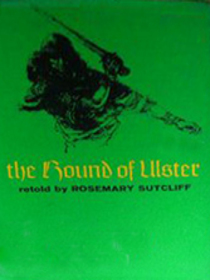I believe I had probably read this book before, when I was very young. However, it's possible that I'd read a different re-telling of these stories.
"The Hound of Ulster" is Cuchulain, the legendary Irish hero, who, when his battle rage was upon him, was undefeatable.
It collects the different tales of Cuchulain, and strings them together into a narrative, much like Howard Pyle's tales of King Arthur.
The language is quite traditional, without using the technique of fleshing out the stories with many completely original details, as is more the mode today. What's here is pretty much just what's in the original tales, but told in an easy-to-follow, enjoyable way.
However, in Sutcliff's introduction, she mentions how one can tell a lot about a people and culture from the tales that they tell... and, reading these, I couldn't help but be reminded (again) of Ursula K. LeGuin's "Gifts," and how she showed in that book how small and petty conflicts and rivalries could be magnified to an importance all out of proportion in an isolated, primitive culture. Here, a good deal of Cuchulain's "heroic" exploits have to do with no more than stealing a neighbor's cattle! It's interesting to read these stories in contrast to so much of the extremely 'elevated' fantasy inspired by Celtic myth.
The book also shows, however, some of the interesting aspects of the culture - how a Queen could sometimes be more powerful than her husband, how bearing a child out of wedlock did not have shame attached, and acceptance of infidelity in marriage - things that are there in the original stories, but surprising, I thought, for a book published in 1963 and marketed to an audience including young people.
"The Hound of Ulster" is Cuchulain, the legendary Irish hero, who, when his battle rage was upon him, was undefeatable.
It collects the different tales of Cuchulain, and strings them together into a narrative, much like Howard Pyle's tales of King Arthur.
The language is quite traditional, without using the technique of fleshing out the stories with many completely original details, as is more the mode today. What's here is pretty much just what's in the original tales, but told in an easy-to-follow, enjoyable way.
However, in Sutcliff's introduction, she mentions how one can tell a lot about a people and culture from the tales that they tell... and, reading these, I couldn't help but be reminded (again) of Ursula K. LeGuin's "Gifts," and how she showed in that book how small and petty conflicts and rivalries could be magnified to an importance all out of proportion in an isolated, primitive culture. Here, a good deal of Cuchulain's "heroic" exploits have to do with no more than stealing a neighbor's cattle! It's interesting to read these stories in contrast to so much of the extremely 'elevated' fantasy inspired by Celtic myth.
The book also shows, however, some of the interesting aspects of the culture - how a Queen could sometimes be more powerful than her husband, how bearing a child out of wedlock did not have shame attached, and acceptance of infidelity in marriage - things that are there in the original stories, but surprising, I thought, for a book published in 1963 and marketed to an audience including young people.




